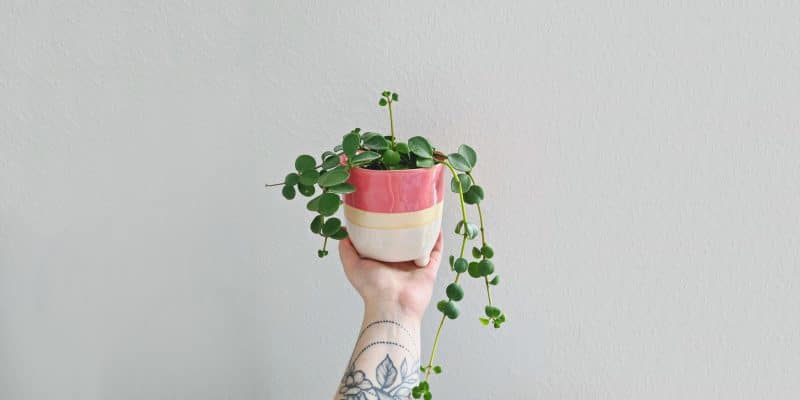Adorable and resilient, Peperomia Hope (Peperomia tetraphylla) should be on your indoor plant wish list.
Known for its coin-shaped, bright green leaves, this lovely plant adds a touch of calm and cheer to any space.
(Have you seen this plant in a hanging basket?)
In our Peperomia Hope care guide, we’ll delve into everything you need to know, from recreating its natural habitat to mastering the perfect balance between light, water, and humidity — and even the art of propagation.
Let’s get you started on your journey to becoming a Peperomia Hope whisperer!
Table of Contents
Peperomia Hope Care
History, habitat, and characteristics
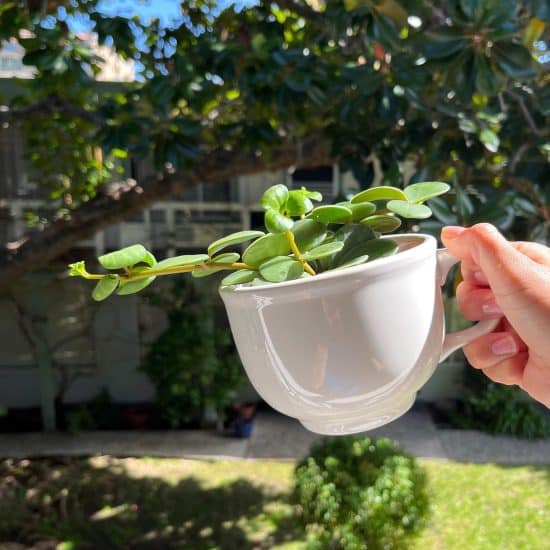
Peperomia Hope, also known by its scientific name, Peperomia tetraphylla, is actually a cultivar, meaning it was specially bred to be a hybrid with its own unique features (so technically, we should be calling it Peperomia tetraphylla ‘Hope’).
It’s a fusion between the Peperomia deppeana and Peperomia quadrifolia species.
Josephus van der Velden invented Peperomia Hope in a laboratory in the Netherlands in February 2007, so compared to most other plants, this variety is fairly new.
The peperomia parents it comes from, though, aren’t. They hail all the way from the tropical regions of Central and South America, and both are related to the black peppercorn plant, Piper nigrum.
In fact, Peperomia Hope’s scientific name comes from the Greek word peperi, or “pepper,” and homoios, or “resembling.” Tetraphylla is Ancient Greek for “four leaves.” Resembling a pepper plant with four leaves.
Not exactly creative, but I’ll take it.
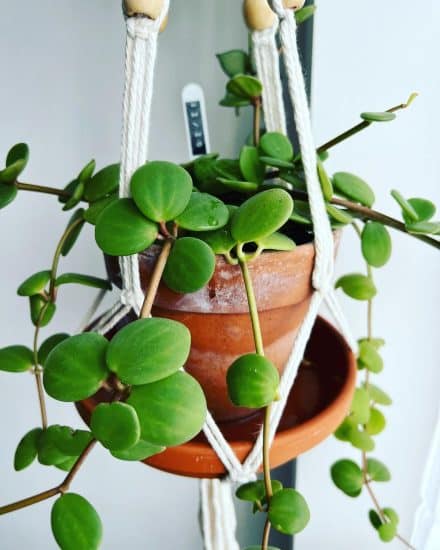
Also known as acorn peperomia and four-leaved peperomia, this plant’s firm, slightly oval leaves only get up to one or two inches wide and resemble small light green coins. Peperomia Hope brings an added sense of calm and charm wherever it resides, almost reminiscent of Japanese design.
Fun fact: Did you know that the Peperomia genus contains over 1,000 different species? But only a small fraction of them are suitable for indoor cultivation. Lucky for us, Peperomia Hope is one of them – adaptable, easy to care for, and oh-so-charming!
One of the best things about Peperomia Hope, aside from its cutesy looks, is its versatility. You can let it grow bushy and compact, or allow it to hang gracefully with trailing stems, creating various looks depending on what tickles your fancy.
Okay, time to launch right into our Peperomia hope care so you can get started on welcoming this lovely tropical plant into your home.
Light
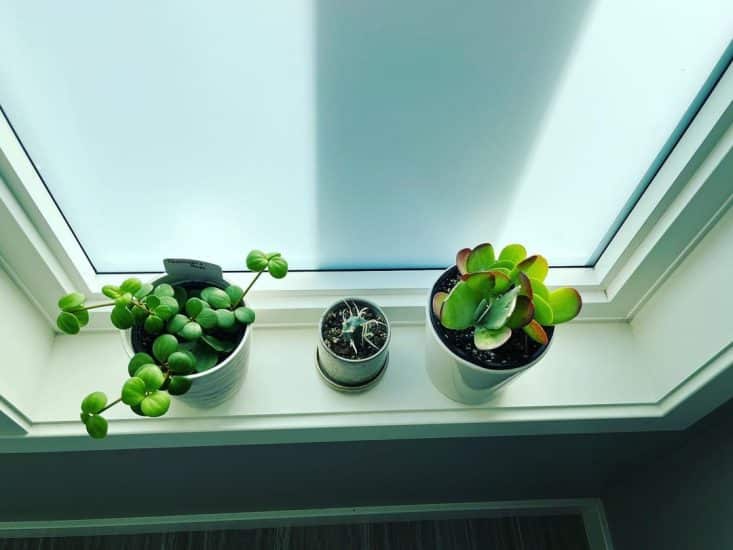
So, you’ve got yourself a beautiful Peperomia Hope, and now you’re wondering about its lighting needs.
This trooper can handle a wide range of lighting conditions. From medium light all the way to dappled direct sunlight, Hope Peperomia is quite forgiving… but there’s a catch. Like all peperomia, it shouldn’t be exposed to direct sun for long periods, as this can cause its leaves to burn.
Yikes! How do you find the perfect spot?
Well, the brighter the light, the better for your Peperomia Hope (just not completely direct with no filter or intermediary). Bright light encourages shorter internodes (the spaces between leaves), making the plant grow faster and more compact.
Think about placing your Peperomia Hope near a north or east-facing window (indirect light), or using a sheer curtain to soften any direct sunlight from south or west-facing exposures.
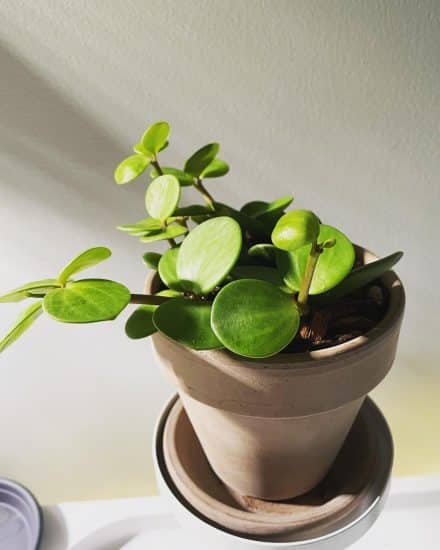
If your plant is in less-than-optimal natural lighting conditions, it can still catch the rays it needs with an LED grow light (better for energy costs), preferably full spectrum.
Now, how can you tell if your Peperomia Hope is loving its new spot or if it needs a bit of a change? Here are some helpful hints.
Not enough light: Is your Peperomia Hope looking a bit sad with slow growth, or stretching out like it’s desperately trying to grab some light? Then it’s time to either move it to a brighter spot (closer to a window) or help it out with a grow light. Problem solved!
Too much light: On the other hand, are the once-vibrant leaves now looking burnt or scorched, maybe even turning an unappealing shade of brown? That’s a sure sign your Peperomia Hope is getting a bit too much sun. Try moving it away from the window or using a sheer curtain for a gentle filtering effect.
Water
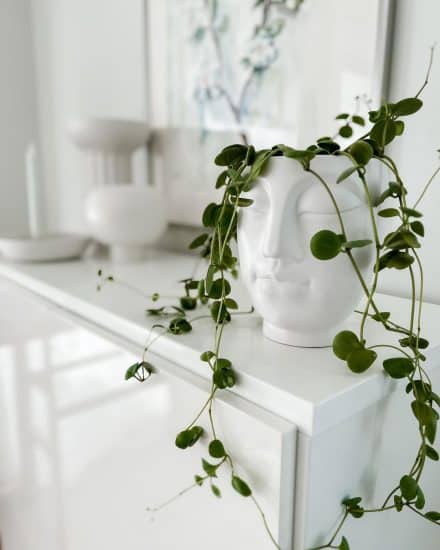
You know how succulents don’t like too much water? Although it’s technically semi-succulent, you should treat your Peperomia Hope the same way. So… how can you tell if it’s time to water? There are two easy methods.
The first is simply to give one of the older leaves a little squeeze or fold (also known as the taco test). If it’s firm, no water needed. But if it’s soft and limp, able to fold up like a taco, it’s time to quench your plant’s thirst.
The other method is to check the top inch or two of soil for dryness before bringing out the watering can again.
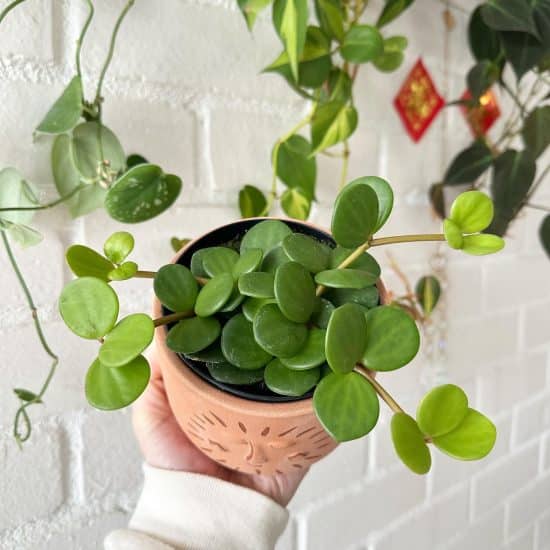
You’ll want to tweak your watering frequency depending on where your Peperomia Hope is hanging out (indoors or outdoors) and the potting mix you’re using. And guess what? It’s totally okay if it takes a bit of time to find that perfect balance.
When it comes to the actual watering process, you’re going to want to really soak the soil — just make sure it drains properly. And definitely let your Peperomia Hope dry out a tad between waterings.
Peperomia Hope watering tips:
- Not enough water looks like wilting leaves or older leaves getting soft and turning yellow.
- Too much water can show up as constantly damp soil, yellowing leaves, and mushy stems (yikes!).
- If rot has joined the party, give your Peperomia Hope a chance to recover by cutting back on watering, and make sure it sits in well-draining soil and a pot with proper drainage holes.
- While tap water is fine for these plants, try to use distilled, filtered, or even rainwater if you’re able, to cut down on chemicals like chlorine and fluoride.
You’ve got this! Just remember that finding the right watering routine for your Peperomia Hope is all about striking that perfect balance between keeping it happy and hydrated without overdoing it.
Temperature and Humidity
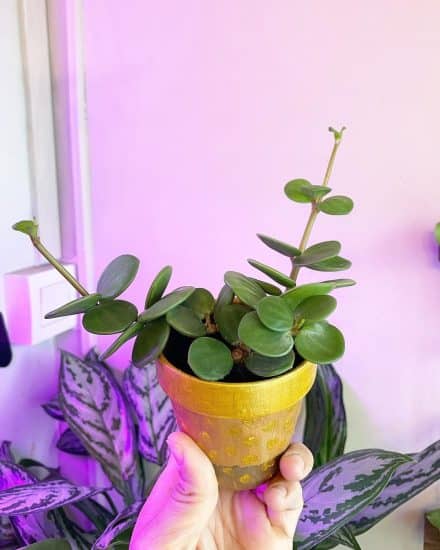
Creating a comfortable environment for Peperomia Hope starts with providing the right temperature and humidity. Native to the tropical regions, Peperomia Hope thrives in consistent temperatures and loves some good ol’ humidity.
Aim for indoor temperatures between 65-75 degrees Fahrenheit to make sure your Peperomia Hope plant stays happy. Be careful of sudden temperature drops, especially during the winter months, as it can cause the plant to suffer.
Keep your Peperomia Hope plant away from cold drafts from windows or doorways, and maintain a consistent temperature to avoid stressing your plant out.
When it comes to humidity, Peperomia Hope can deal with normal household levels, but will really appreciate a moderately humid environment. Either way, for a tropical plant, it honestly isn’t too fussy. Aim for a humidity level of around 40-50% if you can.
If you notice the leaves becoming soft, limp, or slightly wrinkled, this may be a sign that the humidity is too low. On the other hand, if leaves turn yellow and the stems become mushy, this could indicate too much humidity.
If humidity is low (say, consistently below 25%), try placing your Peperomia Hope near a humidifier or using a pebble tray with water underneath it. You can also group it with other humidity-loving plants to create a mini tropical oasis.
Soil and planting
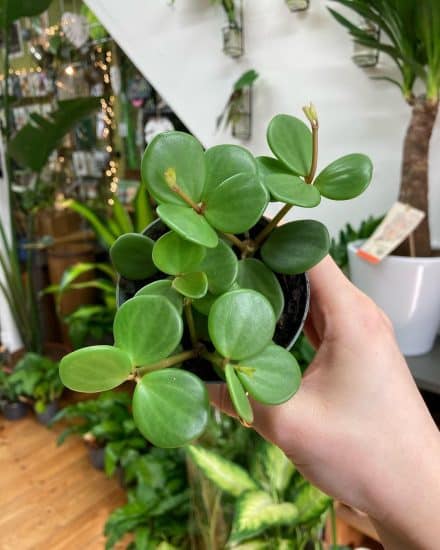
Peperomia Hope thrives in well-draining soil that still retains the right amount of moisture. While it can grow in general-purpose houseplant mixes, we’ve found that it seems to grow faster and thrive in aroid soil mixes.
The ideal pH for your Peperomia hope plant is slightly acidic, between 6.0 and 6.5. A blend of aroid mix with added perlite or coco coir works well to support healthy root growth and moisture retention.
If you want to make your own, we recommend this Peperomia Hope potting soil mix:
- 33% potting soil
- 33% perlite
- 33% orchid bark
Additionally, terracotta pots are a great choice for Peperomia Hope, since they’re porous, dry faster, and provide an attractive color contrast. Just make sure the pot has plenty of drainage to prevent waterlogging — again, these guys are semi-succulents and do not like sitting in excess water.
Pruning
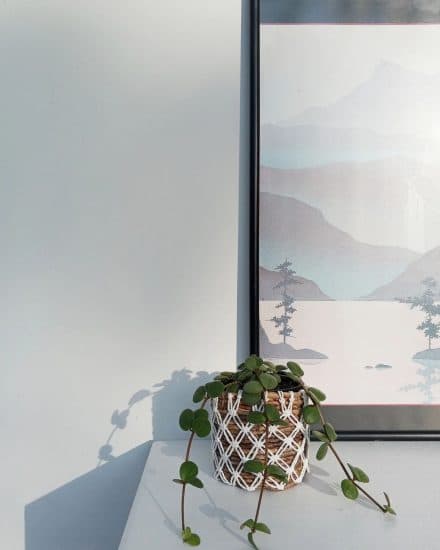
You don’t strictly have to prune your Peperomia Hope plant, but you can if you find it’s getting too leggy or want to encourage bushiness. Try to prune in spring when the plant is actively growing. Pinching or cutting leaves off leaves right above a node, a small place where roots and leaves grow from the stem, will cause the plant to branch out and become fuller.
Repotting
Peperomia Hope shouldn’t need repotting more than every two or three years, as it’s a relatively slow grower. You’ll know when it’s time to repot when roots are poking through your pot’s holes.
Choose a container only one or two inches larger than the current one, ensuring it has drainage holes. Spring is the best time for repotting, as the plant is actively growing and will experience less stress then.
When repotting, handle the roots gently and avoid packing the soil too tightly around the root ball, which can restrict oxygen flow to the roots and potentially lead to rot.
Fertilizing
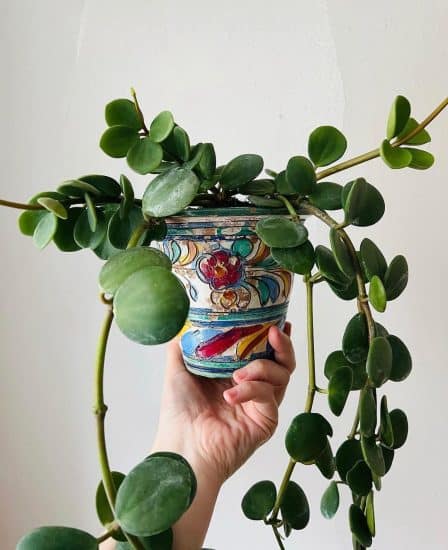
Use a balanced fertilizer diluted to half strength once a month during the growing season (usually spring and summer). Or go organic and mix vermicast, or worm castings, into the top bit of soil instead.
Over-fertilizing can cause symptoms like leaf burn or root damage. If you see these signs, flush the soil with water to remove any excess nutrients. Fertilize less often or with a more diluted amount once the plant recovers.
Congratulations, you know all about how to keep the pep in Peperomia Hope’s growing… step. Now it’s time to learn how to make more of them!
Propagation Guide
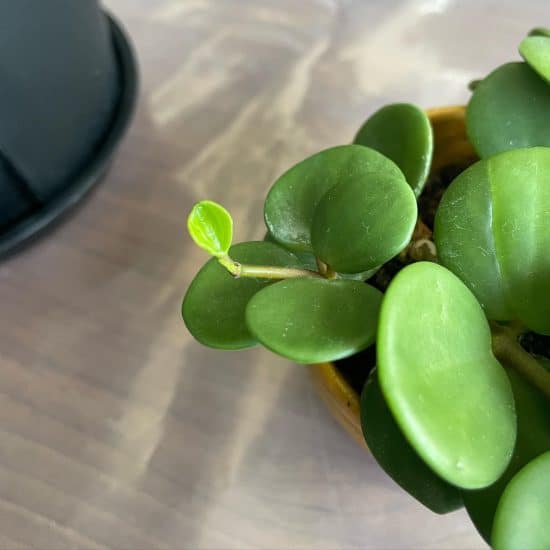
Ready to learn all about propagating Peperomia Hope plants? The usual methods are leaf or stem cuttings, either in water or soil.
Stem cuttings are the fastest, but leaf cuttings are just as effective and fun to watch grow. I’d also recommend soil prop over water for leaf cuttings — less chance of rot. Let’s dive right in.
Propagate Peperomia Hope by leaf cutting in soil:
- Find a healthy fallen leaf or gently pluck one from the mother plant. Make sure it’s in tip-top shape and free from any damage. Important: The area where the stem and leaf join, or the petiole, has to be intact.
- Gently press the cut side of the leaf down into a small container of slightly moist soil.
- Place the container in a bright spot with indirect sunlight (or artificial light).
- Wait patiently for about six to 10 weeks, keeping the soil evenly moist the whole time, and those roots will start to form. It will likely take even longer to see small pups (baby peperomia!) forming above the soil.
- Treat it like the fledgling Peperomia Hope it is — normal watering schedule, etc.! And you’re done!
Propagate Peperomia Hope by stem cutting in water or soil:
- Pick a healthy-looking stem with at least two leaves. Grab your sterilized gardening shears and snip a section about 4-6 inches long, preferably just below a leaf node.
- Remove any leaves from the lower part of the stem cutting, as this is where the magic happens—roots will form!
- For water propagation, place the stem cutting in a small container of water and change it every few days. Find a spot with bright, indirect light or artificial light like grow lights for your cutting. After five to six weeks, those roots should be about 2 inches long, and you can transfer the cutting to a pot with well-draining potting mix.
For soil propagation, simply stick the prepared stem cutting directly into well-draining potting mix and place your pot in a sunny spot with indirect light. Keep the soil consistently moist—think damp, not soggy.
Boom, you’ve propagated Peperomia Hope!
Common issues
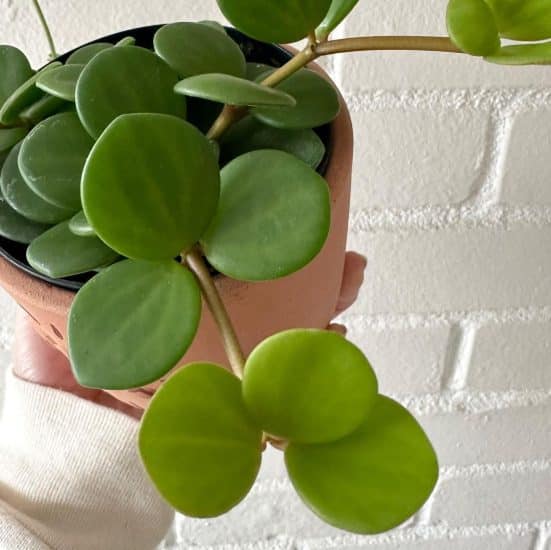
Peperomia Hope can be a pretty laid-back houseplant, but sometimes it runs into a few problems. Here’s how to fix the ones you might see most.
Yellowing leaves
Seeing those once-lush green leaves turning a sad shade of yellow? This issue usually comes down to overwatering, too much sun, or a mix of both. To find the culprit, take a good look at your plant’s lifestyle and habits.
If your plant is sunbathing in direct sun, it’s time for a move to somewhere with bright but indirect light. If overwatering seems to be the problem… (you know where we’re going with this) let the soil dry out a bit between waterings and double-check that the pot has proper drainage holes.
Leggy growth
Is your Peperomia Hope leggy? This can happen if Peperomia plants don’t receive enough light or are overwatered, resulting in thin stems and soft, fleshy leaves falling off the plant. To help prevent leggy growth, ensure your plant receives a lot of bright, indirect light (move it closer to a window if necessary) and only water when the soil is dry one or two inches down.
Once your plant gets leggy, you can’t “fix” it, per se, but you can plant other stems around it to create a bushier look or cut and prop the leggy stem.
Pests and diseases
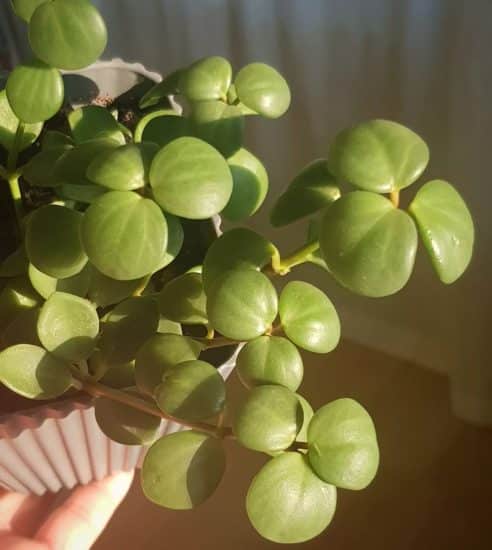
Even though this is a resilient little plant that rarely faces any significant pest or disease issues, problems with Peperomia Hope still happen from time to time. Let’s chat about a couple of things you should watch out for to make sure your plant buddy stays healthy and thriving.
Root Rot
Rotting roots are practically unavoidable for all indoor plants sometimes, including your Peperomia Hope. It’s usually because of too much love (read: water) or soil that doesn’t drain well, and the poor roots end up soaked, unable to breathe, and rotting. To water your plant correctly, make sure to keep the soil moist but not drenched.
To spot rot, keep an eye out for leaves turning yellow and soft stems wilting. When you take the plant out of its pot, you might see roots that are discolored, slimy, and mushy (yuck).
Solution: To fix root rot, gently remove the plant from its pot and snip away any affected roots with clean, sterilized scissors (better safe than sorry, right?). Give your plant a fresh start by repotting it in well-draining potting soil with some perlite or pumice thrown in to help with aeration and drainage.
A fresh soil mixture can make a significant difference. Don’t forget to use a pot with drainage to avoid standing water, and only water your plant when the soil is dry to the touch.
To keep root rot from returning, let the soil dry out between waterings and don’t let your plant sit in water for too long. When you do water, make sure the soil ends up moist but not drenched (the water should flow through it well enough to prevent soil mud).
Pests
Peperomia Hope might be pretty resistant to pests (lucky you!), but mealybugs, scale, aphids, and especially spider mites can still be a bit of a headache. We’ll focus on spider mites here.
These tiny troublemakers can be hard to spot, but if left unchecked, they can cause some serious damage to your plant.
To find spider mites, look for fine webbing on your plant’s leaves and stems, as well as small, discolored spots on the leaves. If you have really good eyesight, you might even see tiny, moving dots – yep, those are the mites themselves.
Solution: Should you encounter a spider mite invasion, move your plant away from other green friends to avoid spreading the mites. Give your plant a shower by spraying it with water to dislodge the mites (they hate water, so this is a win).
Treat your plant with a mix of water and a few drops of mild dish soap or diluted neem oil, making sure to cover all leaves and stems. It might seem tedious, but trust me, it’s worth it.
Repeat the treatment every few days until you’re sure the infestation is gone and even for a week or two afterward to dislodge any eggs (better safe than sorry, right?).
To keep spider mites at bay in the future, make sure your Peperomia Hope plant is surrounded by humidity that’s on the higher side (aim for at least 50%), as those pesky mites adore dry conditions. Wipe your plant’s leaves clean with a soft wet cloth to remove any existing pests.
Plus, make it a habit to inspect your plant every now and then for early signs of infestation. Catching any issues early can save you and your plant a lot of trouble!
Conclusion
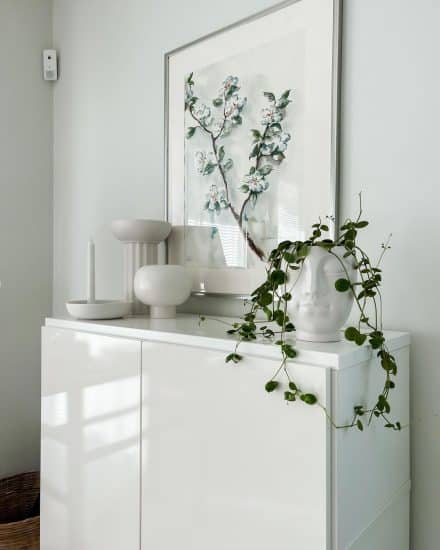
Now you should know how to care for Peperomia hope and adapt to any challenges that might come your way.
We hope this guide has been helpful and inspires you to welcome a Peperomia Hope into your home. If you found it useful, share it with fellow plant enthusiasts.
And don’t hesitate to reach out on Facebook or Twitter if you have any questions or concerns (and if you feel like it, snap a pic of your plant and send it our way!).
Happy gardening!
FAQ
Is Peperomia Hope toxic?
According to the ASPCA, most peperomia are non-toxic to pets and children, so it’s safe to have them co-exist in your home. Still, your best bet is to keep Peperomia Hope away from kids and animals, since it isn’t meant to be ingested.
Is Peperomia Hope easy to take care of?
Yup! It’s highly adaptable to light conditions, temperature, and humidity. I consider it a low-maintenance houseplant that can thrive easily when you give it what it needs.
Is Peperomia Hope rare?
Nope, but it’s still a unique and charming cultivar, a hybrid of the Peperomia deppeana and Peperomia quadrifolia species. Its cheerful, succulent-like foliage and adaptability to indoor conditions (read: not fussy) make it popular among plant lovers.
Why are the leaves falling off my Peperomia Hope?
This can be due to several factors, including overwatering, underwatering, or sudden changes in temperature or light conditions. We address this issue in more detail in the “Common issues” section.
Do Peperomia Hope climb?
Peperomia Hope doesn’t climb naturally like some other vining plants. However, it can have a trailing growth habit if provided with the right support or allowed to spill over the edges of its pot.

